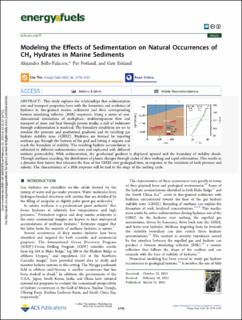| dc.contributor.author | Bello Palacios, German Alejandro | |
| dc.contributor.author | Fotland, Per | |
| dc.contributor.author | Ersland, Geir | |
| dc.date.accessioned | 2023-04-03T12:05:58Z | |
| dc.date.available | 2023-04-03T12:05:58Z | |
| dc.date.created | 2022-06-10T09:09:56Z | |
| dc.date.issued | 2022 | |
| dc.identifier.issn | 0887-0624 | |
| dc.identifier.uri | https://hdl.handle.net/11250/3061828 | |
| dc.description.abstract | This study explores the relationships that sedimentation rate and transport properties have with the formation and evolution of hydrates in fine-grained marine sediments and their corresponding bottom simulating reflector (BSR) responses. Using a series of one-dimensional simulations of multiphase, multicomponent flow and transport of mass and heat through porous media, a slab of sediments through sedimentation is modeled. The boundary conditions are set to emulate the pressure and geothermal gradients and its resulting gas hydrate stability zone (GHSZ). Hydrates are formed by injecting methane gas through the bottom of the grid and letting it migrate and reach the boundary of stability. The resulting hydrate accumulation is subjected to different sedimentation rates and replicated with different intrinsic permeability. With sedimentation, the geothermal gradient is displaced upward and the boundary of stability shoals. Through methane recycling, the distribution of phases changes through cycles of slow melting and rapid reformation. This results in a dynamic flow barrier that relocates the base of the GHSZ over geological time, in response to the variations of both pressure and salinity. The characteristics of a BSR response will be tied to the stage of the melting cycle. | en_US |
| dc.language.iso | eng | en_US |
| dc.publisher | ACS | en_US |
| dc.rights | Navngivelse 4.0 Internasjonal | * |
| dc.rights.uri | http://creativecommons.org/licenses/by/4.0/deed.no | * |
| dc.title | Modeling the Effects of Sedimentation on Natural Occurrences of CH4 Hydrates in Marine Sediments | en_US |
| dc.type | Journal article | en_US |
| dc.type | Peer reviewed | en_US |
| dc.description.version | publishedVersion | en_US |
| dc.rights.holder | Copyright 2022 The Author(s) | en_US |
| cristin.ispublished | true | |
| cristin.fulltext | original | |
| cristin.qualitycode | 2 | |
| dc.identifier.doi | 10.1021/acs.energyfuels.1c03611 | |
| dc.identifier.cristin | 2030682 | |
| dc.source.journal | Energy & Fuels | en_US |
| dc.source.pagenumber | 3778-3787 | en_US |
| dc.identifier.citation | Energy & Fuels. 2022, 36 (7), 3778-3787. | en_US |
| dc.source.volume | 36 | en_US |
| dc.source.issue | 7 | en_US |

